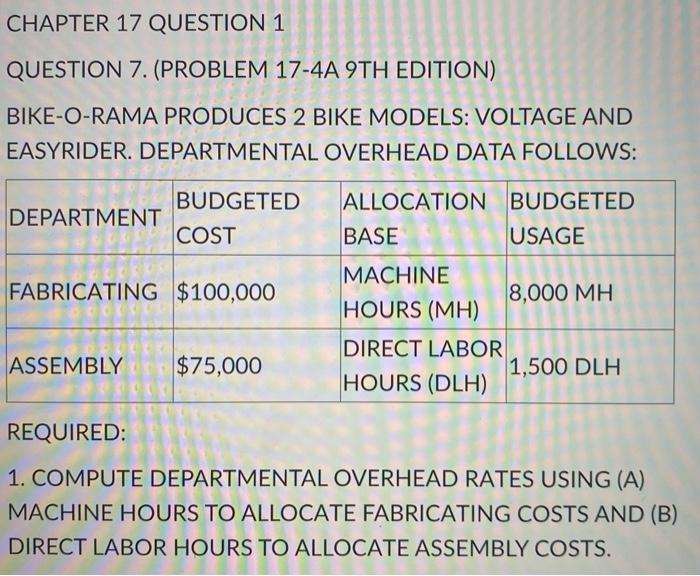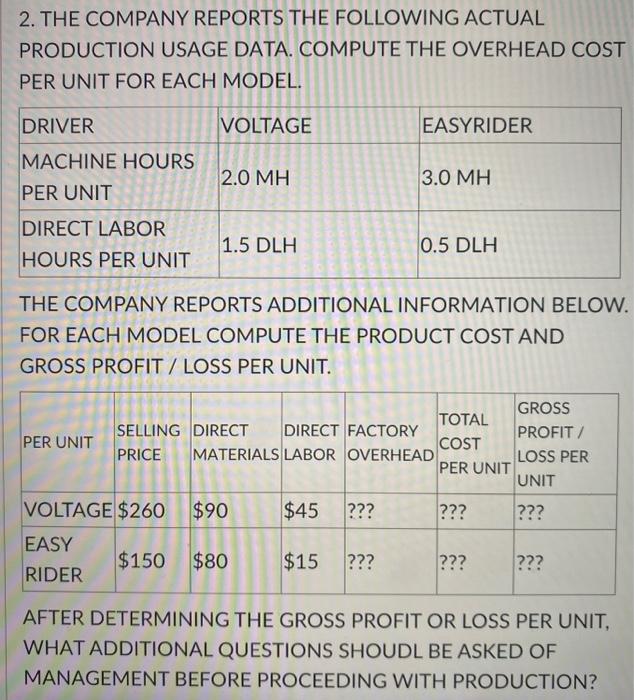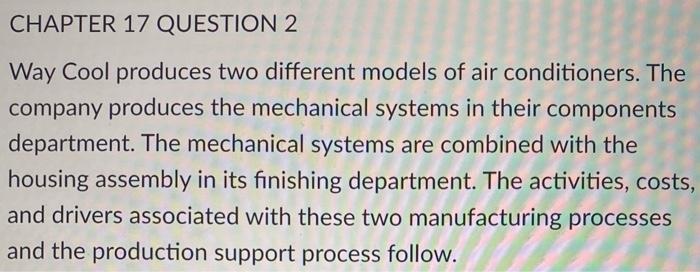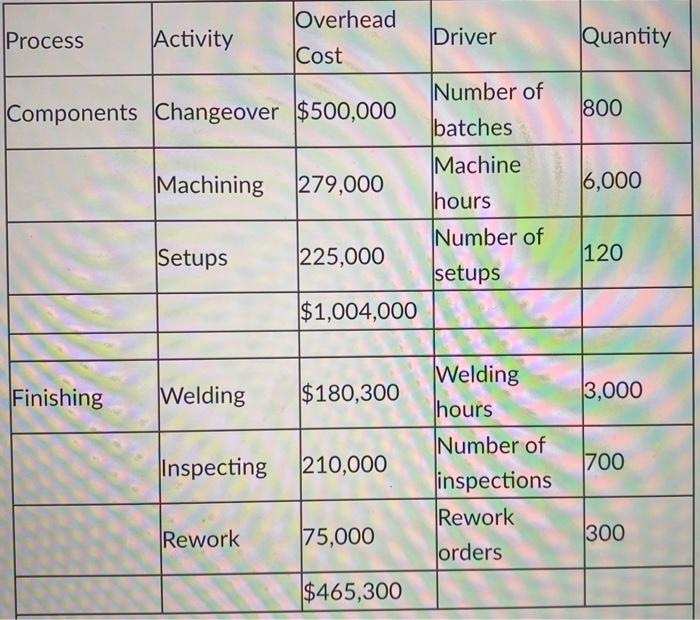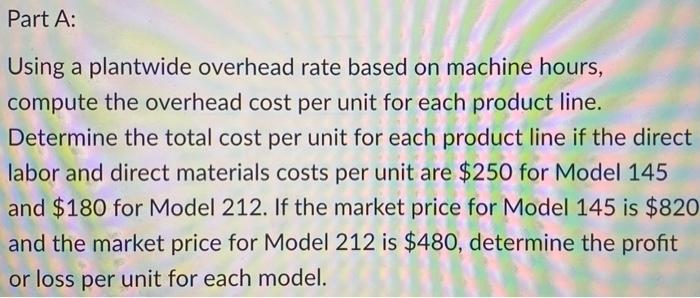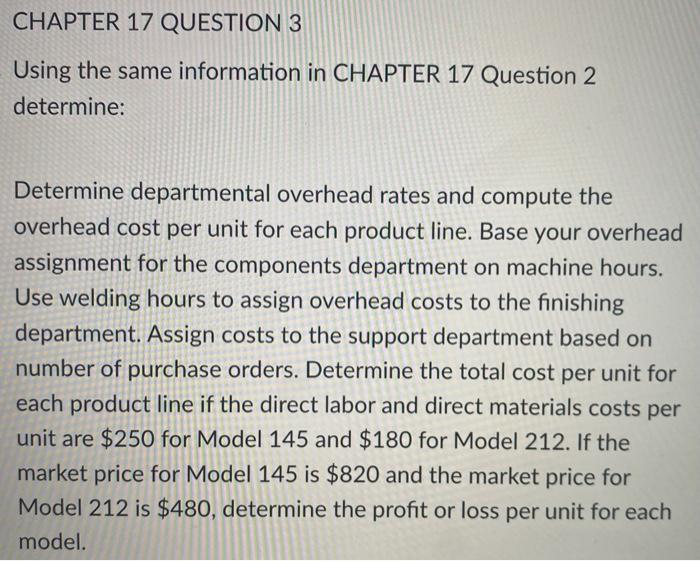CHAPTER 17 QUESTION 1 QUESTION 7. (PROBLEM 17-4A 9TH EDITION) BIKE-O-RAMA PRODUCES 2 BIKE MODELS: VOLTAGE AND EASYRIDER. DEPARTMENTAL OVERHEAD DATA FOLLOWS: BUDGETED DEPARTMENT COST ALLOCATION BUDGETED BASE USAGE FABRICATING $100,000 MACHINE 8,000 MH HOURS (MH) DIRECT LABOR 1,500 DLH HOURS (DLH) ASSEMBLY $75,000 REQUIRED: 1. COMPUTE DEPARTMENTAL OVERHEAD RATES USING (A) MACHINE HOURS TO ALLOCATE FABRICATING COSTS AND (B) DIRECT LABOR HOURS TO ALLOCATE ASSEMBLY COSTS. 2. THE COMPANY REPORTS THE FOLLOWING ACTUAL PRODUCTION USAGE DATA. COMPUTE THE OVERHEAD COST PER UNIT FOR EACH MODEL. DRIVER VOLTAGE EASYRIDER MACHINE HOURS PER UNIT 2.0 MH 3.0 MH DIRECT LABOR HOURS PER UNIT 1.5 DLH 0.5 DLH THE COMPANY REPORTS ADDITIONAL INFORMATION BELOW. FOR EACH MODEL COMPUTE THE PRODUCT COST AND GROSS PROFIT/ LOSS PER UNIT. GROSS TOTAL SELLING DIRECT DIRECT FACTORY PROFIT / PER UNIT COST PRICE MATERIALS LABOR OVERHEAD LOSS PER PER UNIT UNIT VOLTAGE $260 $90 $45 ??? ??? ??? EASY $150 $80 $15 ??? ??? ??? RIDER AFTER DETERMINING THE GROSS PROFIT OR LOSS PER UNIT, WHAT ADDITIONAL QUESTIONS SHOUDL BE ASKED OF MANAGEMENT BEFORE PROCEEDING WITH PRODUCTION? CHAPTER 17 QUESTION 2 Way Cool produces two different models of air conditioners. The company produces the mechanical systems in their components department. The mechanical systems are combined with the housing assembly in its finishing department. The activities, costs, and drivers associated with these two manufacturing processes and the production support process follow. Process Activity Overhead Cost Driver Quantity Components Changeover $500,000 Number of batches 800 Machining 279,000 Machine hours 16,000 Number of Setups 225,000 120 setups $1,004,000 Finishing Welding $180,300 3,000 Inspecting 210,000 Welding hours Number of inspections Rework orders 700 Rework 75,000 300 $465,300 Support Purchasing $135,000 Purchase orders 450 Number of 32,000 5,000 lunits Providing space Providing utilities 65,000 Number of units 5,000 $232,000 Additional information about the two produced units is as follows: Model 145 Model 212 1,500 800 3,500 2,200 400 400 400 300 Units produced Welding hours Batches Number of inspections Machine hours Setups Rework orders Purchase orders 1,800 4,200 160 160 160 140 300 150 Part A: Using a plantwide overhead rate based on machine hours, compute the overhead cost per unit for each product line. Determine the total cost per unit for each product line if the direct labor and direct materials costs per unit are $250 for Model 145 and $180 for Model 212. If the market price for Model 145 is $820 and the market price for Model 212 is $480, determine the profit or loss per unit for each model. CHAPTER 17 QUESTION 3 Using the same information in CHAPTER 17 Question 2 determine: Determine departmental overhead rates and compute the overhead cost per unit for each product line. Base your overhead assignment for the components department on machine hours. Use welding hours to assign overhead costs to the finishing department. Assign costs to the support department based on number of purchase orders. Determine the total cost per unit for each product line if the direct labor and direct materials costs per unit are $250 for Model 145 and $180 for Model 212. If the market price for Model 145 is $820 and the market price for Model 212 is $480, determine the profit or loss per unit for each model
